
Misconceptions about eucalypts abound. They seem to be as widespread and diverse as the eucalypts themselves. Many people realise that such misconceptions are just that – myths. In fact, when I posted on social media the question ‘What’s the eucalypt-related misconception that frustrates you the most?’, I received over 200 responses in less than 24 hours! The majority of the eucalypt myths that frustrate people broadly fit in one of these categories:
– Size myths (they’re too big for urban areas)
– Danger myths (they fall over, they shed branches, and they’re out to get you!)
– Garden myths (they have invasive roots, the leaves poison the soil, etc.)
– Fire myths (they need fire, they cause fire, they spontaneously combust…)
– Koala myths (and the related Drop Bear myth…)
– Plus over 20 other eucalypt myths of varying types.
Like any good myth, their origins often contain an element of truth. Eucalypts include some of the tallest trees in the world. Some eucalypts can shed branches. Many eucalypts are adapted to wildfire. Eucalypts do have roots. And koalas do eat eucalypts. But if you dig a little deeper, most of these eucalypt myths are based on gross generalisations, to the point of being quite misleading.
Let’s dig into these myth categories one by one.
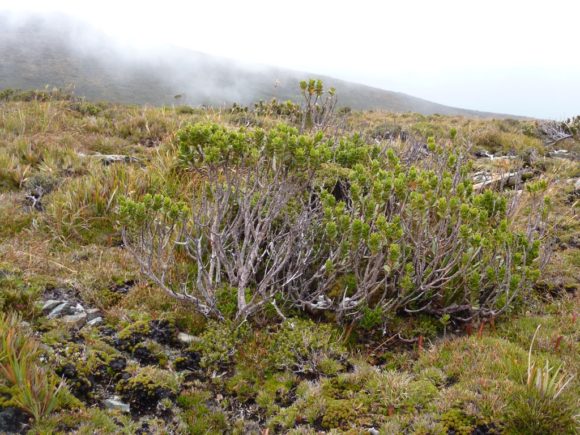
This is one half of the ‘dirty great big gum tree’ myth. It’s the misconception that has unfortunately put people off planting eucalypts in parks, streets and gardens. The myth was reinforced through the 1970s and 80s when eucalypts were commonly planted in suburban backyards, sometimes as handouts from local councils. Unfortunately, the species planted were typically the larger and faster-growing forest eucalypts: species such as the Lemon-scented Gum (C. citriodora) and Tasmanian Blue Gum (E. globulus).
In reality, the eucalypts are a diverse group of plants in their form and mature size. Of the 850 eucalypt species currently recognised (over a third of them are mallees or shrubs.
That’s 309 eucalypt species that don’t even grow into trees! It includes numerous highly ornamental species suitable for gardens, including the smallest of them all, the Varnished Mallee (E. vernicosa), which is commonly grown as a container plant in Europe.
Of the remaining 541 eucalypts that can indeed grow into trees, 127 of them are small trees growing no taller than eight metres, and include many outstanding ornamentals such as the Red-capped Gum (E. erythrocorys) and the Silver Gimlet (E. campaspe). This means that over half of all eucalypt species are multi-trunked mallees, shrubs, or trees less than eight metres tall, all of which are well suited to urban planting.
The other half of the ‘dirty great big gum tree’ myth.
We have already established that over half of all eucalypt species are multi-trunked mallees, shrubs, or small trees less than eight metres tall. But a proportion of the 850 eucalypt species do grow into much larger trees and, like large trees of any type, these larger-growing eucalypt species can shed branches. Some fast-growing forest eucalypts – Sugar Gums (E. cladocalyx) for example – are more prone to shedding branches than others, especially if the branches are over-extended and heavily end-weighted.
But most eucalypts are either too small to be a danger or no more likely to shed branches than any other type of tree.
More generally, many studies conclude that the risks represented by falling tree branches (whether from a eucalypt or any other tree) is grossly overstated. Under normal weather conditions, you are far more likely to die from melanoma or heat stroke from not standing under a tree (even a ‘dirty great big gum tree’) than be injured from a falling branch while standing under that same tree. The odds change somewhat in a storm, of course. Keep that in mind, and trees will be your friends, helping you to live longer and healthier!
If an arborist tells you that a eucalypt (or indeed any tree) needs removing because it has borers or termites, or tells you that you need to remove mistletoe from a tree to save it, ask yourself if they have a conflict of interest. Do they also receive income from removing trees or mistletoe?
Borers, termites, and mistletoe are part of the biodiversity often found in larger, older eucalypts (typically in the larger-growing tree species), where they can co-exist for many centuries, without any intervention from us. All of the biggest and oldest River Red Gums (like the famous Cazneaux Tree, the Herbig Family Tree, Bilston’s Tree and the Guildford Tree) have borers and termites, and have lived with these animals for many centuries. Many of these trees have also had mistletoe growing in them for a similar period of time. Borers, termites, and mistletoe need to be looked at as biodiversity, not pests!

Because they have evolved together, eucalypts and these organisms are generally in balance. Eucalypts combat borers by exuding sap, which suffocates many of them, keeping their number at bay.
Termites only eat dead wood, including the dead heartwood of a live tree, such that they do not impact the health of the tree at all (although they can increase the tree’s likelihood of structural failure). And mistletoe, a parasitic plant, only becomes problematic for a tree when it builds up in number such that the tree cannot sustain them all, which is uncommon.
So if someone tells you that you need to remove mistletoe from a tree to save it, you can almost certainly ignore this advice. And if an arborist suggests that a tree needs removing because it has borers or termites (unless a weakened trunk or branch poses a direct threat to property), tell them you don’t want their business. Save the tree and all its biodiversity instead!
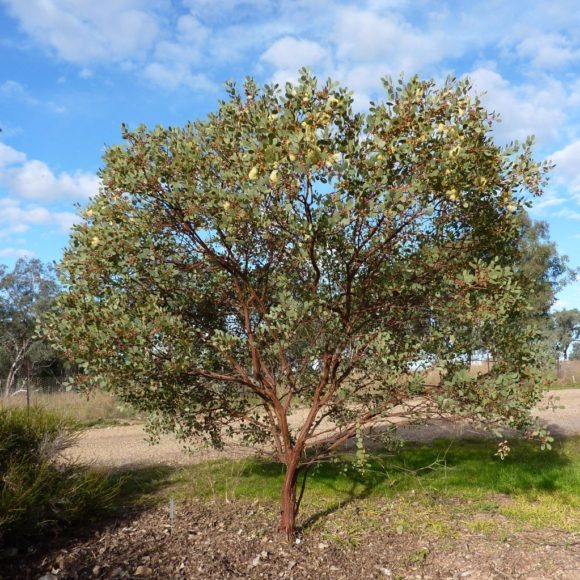
‘Invasive’: what does that mean? Generally speaking, the roots of many trees, including many eucalypts, are opportunistic. Opportunistic roots grow along lines of least resistance and most resources (water, air and nutrient). A utility trench filled with sand is often the line of less resistance for opportunistic roots. A leaky sewer pipe is a point of concentrated resources (water and nutrients), and thus roots will grow there. If roots are entering a pipe, it means that there is already a fault causing a leak in the pipe.
Alternatively, a concrete foundation and a sealed PVC pipe represent both a physical barrier to any roots and also provide no resources, such that roots will treat them as they would any other physical barrier in the ground (such as a rock).
If we look at eucalypts more specifically, it is difficult to generalise with regard to their roots, because there appears to be much diversity in root distribution within the soil.
Some species have a fairly compact root system (including many of the smaller-growing species). Some, like the stringybarks, have a root system biased towards shallow near-surface roots, while others, such as the River Red Gum, have generally deeper roots. But roots from all would enter a leaky sewer or stormwater pipe, as would the roots of any other tree or plant.
This myth is perpetuated because it can sometimes be difficult to grow a lawn or smaller garden plants underneath a eucalypt, as it can be beneath any tree. Usually it is because the tree casts too much shade and/or is too competitive for soil moisture. But are eucalypts actually allelopathic? That is, do they inhibit the growth of other plants by secreting chemicals from their leaves?
Studies at Currency Creek Arboretum indicate that there is much variation between eucalypt species with regard to what will grow beneath them.
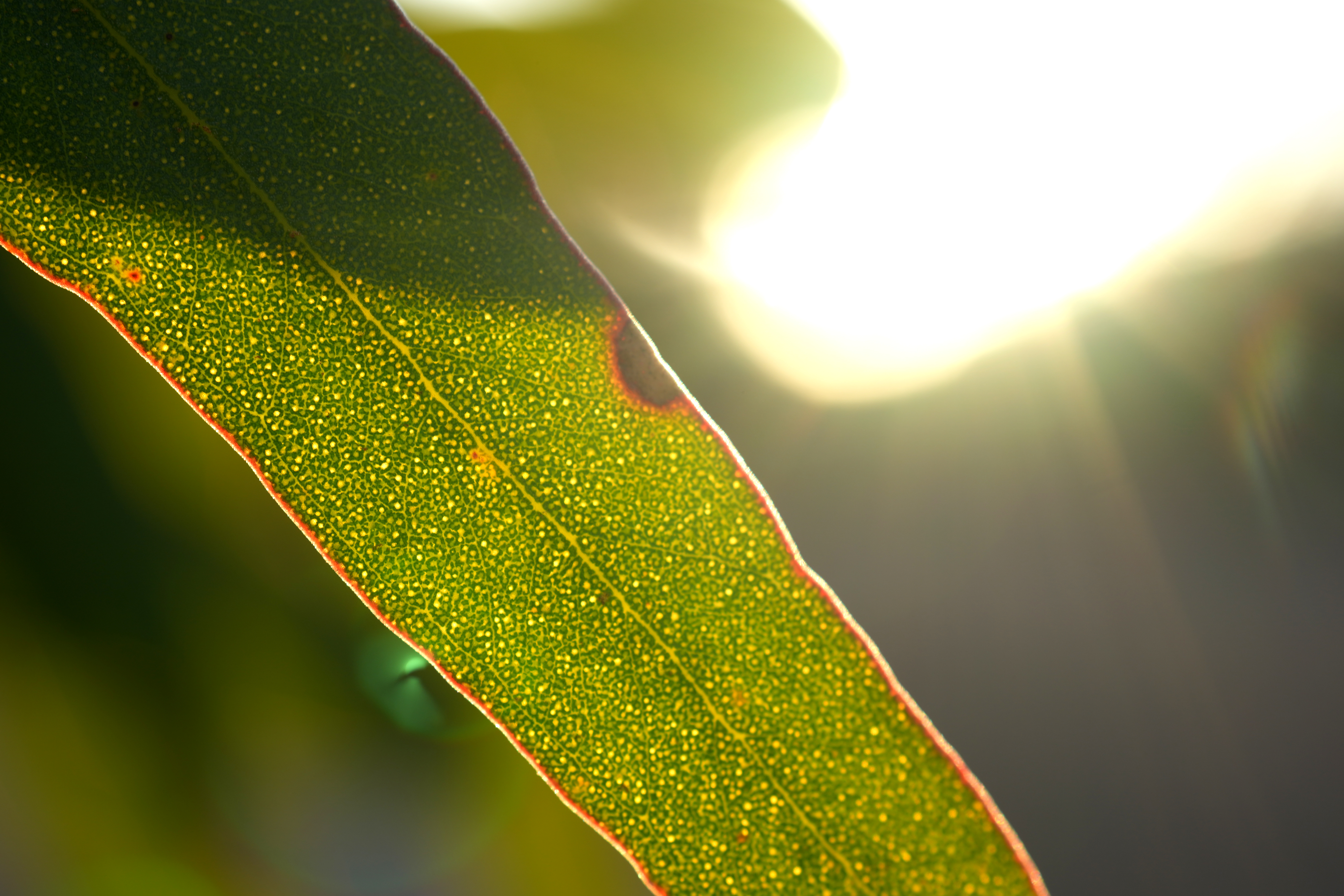
Some species consistently have dense grasses and herbaceous plants growing up to their base, while others are surrounded by mostly bare ground. Seasonal grass-curing observations indicate that most of this variation between species is due to their root distribution and water use. Low water-demanding species like the Heart-leaved Mallee (E. websteriana) and deep-rooted species such as the Spotted Gum (C. maculata) tend not to inhibit grasses and other plants at all.
High water-demanding species, especially those whose roots tend to grow very near the surface – Warty Yate (E. megacornuta), for instance – tend to inhibit the growth of grasses and other plants, as they are able to out-compete them for near-surface soil moisture. Shading can also prevent other plants from growing underneath the canopy, especially in dense-foliaged species such as the Western Australian Red-flowering Gum.
A recent study examining allelopathy in Tasmanian Blue Gum plantations in California has concluded that, while the trees do inhibit the growth of some Californian native understorey species, this inhibition is no more significant than that caused by their native oaks. The Californian and Currency Creek studies suggest that allelopathy in eucalypts is likely to be overstated, and may be no more apparent than in any other type of tree.
More information and advice about selecting eucalypts for the home garden is available in Smaller Eucalypts for Planting in Australia and Taller Eucalypts for Planting in Australia.
There is a lot to unwrap here. These myths have been around for a long time, but have recently been perpetuated by the devastating 2019/20 fires in eastern Australia. Let’s look at these individually.
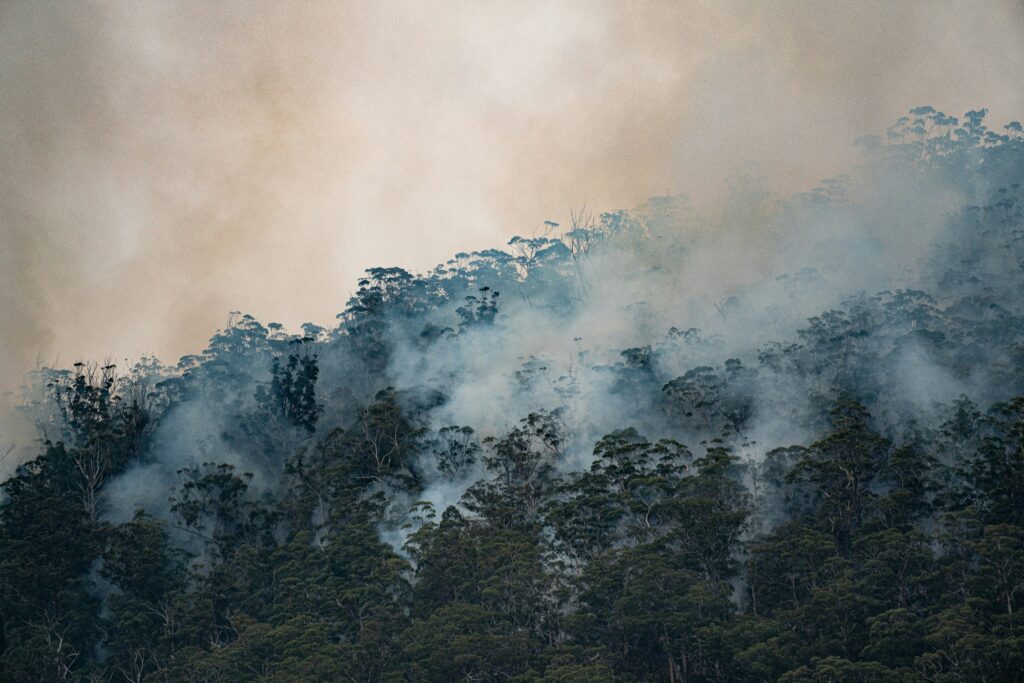
There is no eucalypt species that needs fire (or smoke) for their fruits to release the seeds or for the seeds to germinate. This is why you can collect, extract and sow the seeds of any eucalypt without the need for fire. However, fire plays a big role in the success of seedlings in the wild, by enabling the mass release of seed, and by removing competition from other species for water and sunlight.
About 90% of all species have the ability to resprout after fire, from the branches, trunk or lignotuber (a woody swelling at ground level). But 10% of eucalypts (85 species) are actually non-resprouters – following a fire they regenerate only from seeds. These 85 fire-sensitive, non-resprouting species are susceptible to frequent fires.
They require fire intervals longer than their generation time (8 to 25 years, depending on the species). They are prone to extinction wherever the fire interval is shorter than their generation time.

Entire populations of a number of these non-resprouting species were burnt in the recent wildfires, rendering them vulnerable to extinction if another fire occurs in the next decade or so. The entire population of the rare non-resprouting species Wadbilliga Ash (E. paliformis), Woila Gum (E. olsenii) and Jilliga Ash (E. stenostoma) were recently burnt in Deua National Park in New South Wales. Similarly in the Great Western Woodlands of Western Australia, the entire distribution of the non-respouting species Bronzite Ridge Mallet (E. distuberosa subsp. aerata), Norseman Mallet (E. pterocarpa) and Fulgida Mallet (E. georgei subsp. fulgida) appears to have been burnt in the 2019/20 fires this summer.

More than anything else, the flammability of plant material is correlated to its ‘thinness’ (surface area to volume ratio) and its moisture content. In the heat of summer under drought conditions, all plant material will be drier than otherwise. In these conditions, the ‘thin’ parts of eucalypts and other trees, such as the twigs, leaves and loose bark, become more flammable as they dry out. This phenomenon has significantly complicated the research into the flammability of different tree species.
Relatively few of the 850 eucalypts have been tested for their flammability. In some studies, the shoots (leaves and twigs) of eucalypts tend to be categorised as having ‘high’ flammability, but not necessarily more so than in certain other tree species, including:
Acacia (wattle), Dacrydium (rimu), Nothofagus (southern beech) and Pinus (pine).
It is worth noting that in the bulk of the areas burnt in the recent eastern Australia bushfires, the eucalypt canopy leaves showed evidence of having browned and died from heat, but not having caught fire when the understorey vegetation burned.
Most live foliage of any species can burn when engulfed by a flame from below or exposed to its super-heated gases above 500–600°C. The heat evaporates moisture from the leaf and ignites the foliage. The 1–2% of oil present in the foliage of many eucalypts adds very little to flammability or flame size.
The type of bark on a eucalypt species is probably correlated to its flammability, but the necessary studies haven’t been done to provide data on this. For example, species that shed bark in long thin ribbons that remain hanging in the canopy, such as the Manna Gum (E. viminalis), are likely to be relatively flammable, whereas species with smooth bark that is shed cleanly in small plates like Spotted Gum (C. maculata) and those with hard, non-shedding bark like ironbarks are likely to be relatively low in flammability. Large areas of Spotted Gum forest were recently burnt along the New South Wales south coast, but relatively little of the canopy burnt.
There is no evidence of this ever occurring. Nor is there even any evidence of Eucalyptus oil-filled air exploding on a hot day when exposed to a spark or flame. Within the treetops the fuel-air ratio is only ever a fraction of what is required for the volatile gases to explode. Pyrolysis (the thermal decomposition of plant material into flammable gases) begins at 300°C when volatile gases evaporate and collect in high concentration at the surface of fuel such as leaves or bark. Such a scenario would only occur as a result of a nearby fire.
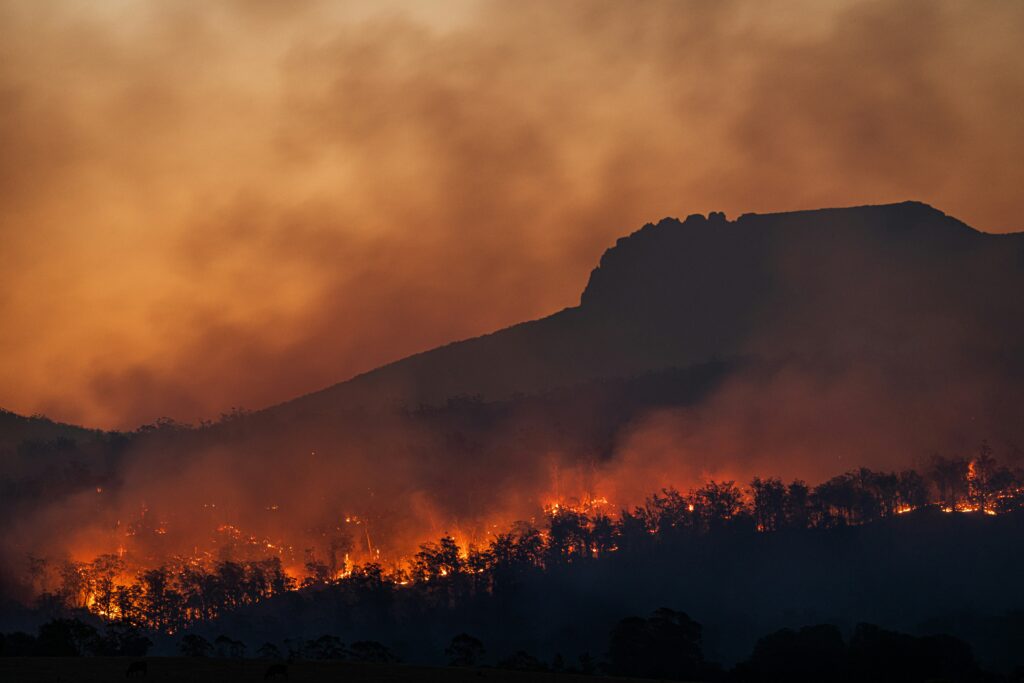
‘Fire balls’ can occur in wildfires, but this is not a phenomenon unique to eucalypt forests. Areas of volatile gases can form above rapidly heated fuel in a wildfire.
If these areas of volatile gases become ignited, the flame rises at a few metres per second. Carried by a wind gust, these ignited gases can be seen as a small fire ball through the sky, lasting less than a second and travelling less than a few metres.
These fire balls are sometimes seen in intense wildfires burning under optimum fire conditions, with high air flow and high temperatures. In Australia, this is typically vegetation dominated by eucalypts, but elsewhere it is commonly seen in vegetation dominated by pine and cypress species, such as in recent fires in California, Spain and Greece. We also saw this in the 2003 Canberra bushfires, involving pine plantations ‘exploding’ on the outskirts of the city.

It is sometimes claimed that angophoras (plants from the genus Angophora), as well as bloodwoods and ghost gums (plants from the genus Corymbia) are not eucalypts, because they are not in the genus Eucalyptus. This is a misinformed claim.
In fact, ‘eucalypt’ is a common name used for any member of Angophora (about 12 species), Corymbia (about 100 species) and Eucalyptus (with about 750 species). Collectively they are all eucalypts!
These three genera are closely related and have many similar characteristics.
Angophora includes some of eastern Australia’s most characteristic eucalypts, such as the Sydney Red Gum (Angophora costata). Corymbia includes some of our most-loved eucalypts, such as the Central Australian Ghost Gum (Corymbia aparrerinja), Lemon-scented Gum (Corymbia citriodora) and the Western Australian Red-flowering Gum (Corymbia ficifolia).

‘Koalas eat any eucalypt / only eat certain eucalypts / only eat eucalypts’
All three of these statements are somewhat misleading.
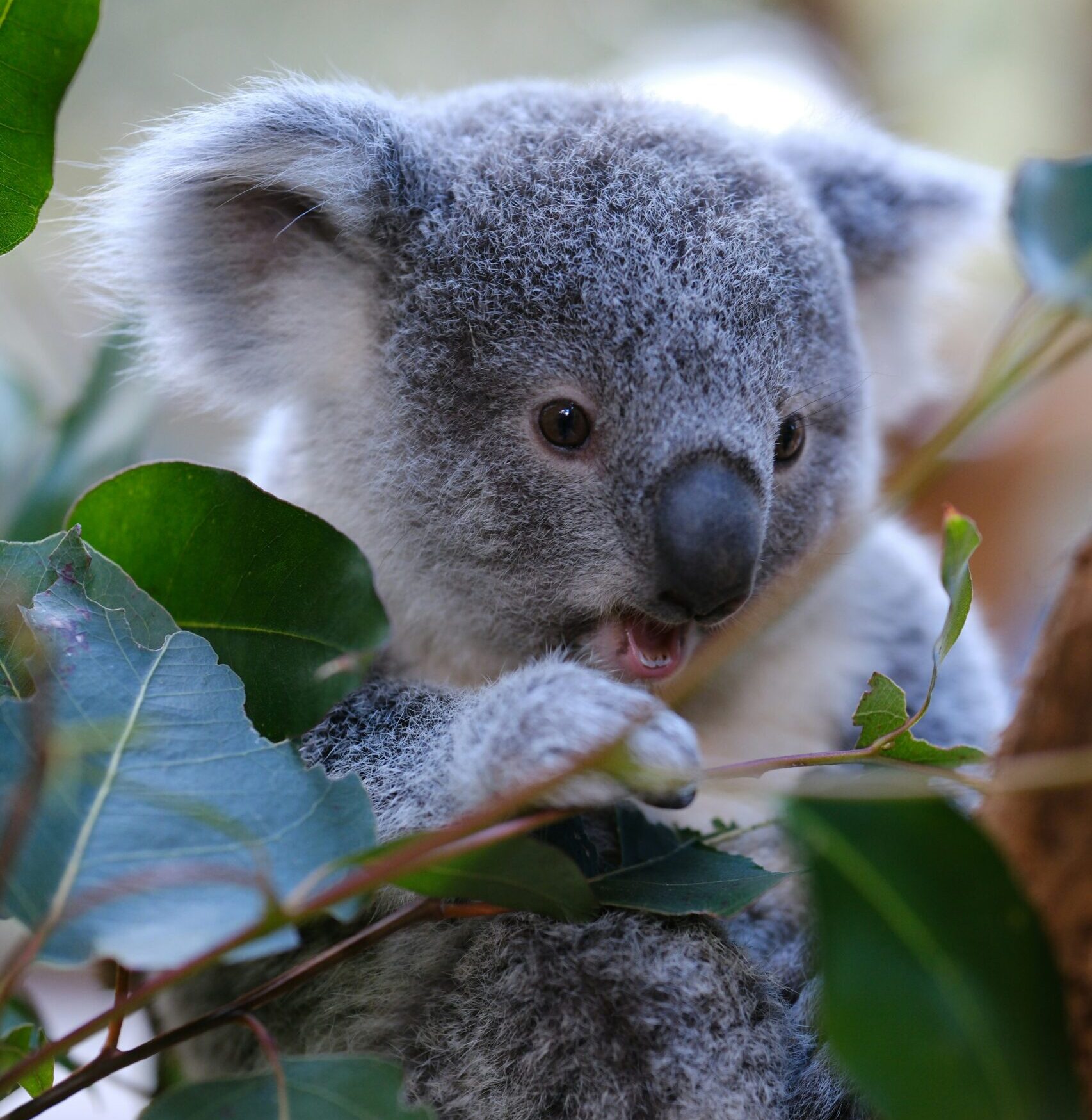
Koalas are known to be fairly fussy eaters and generally decide whether they want to eat a leaf based on prior experience and the cues that are available – mostly taste and odour. This is why koalas not only prefer certain eucalypt species, but often show greater discrimination between individual trees within a species than between different species. Individual koalas also have individual preferences; some koalas will be happy munching on a certain tree, while others refuse to eat a single leaf from the very same tree!
There are many eucalypt species that koalas don’t eat in the wild, but this is primarily a matter of geography. The distribution of koalas in south-eastern Australia only overlaps with about a quarter of the 850 eucalypt species, so those are the species that koalas eat in the wild. But when other eucalypt species and koalas are brought together (in captivity for example), koalas will happily eat their leaves too. In fact, captive koalas in South Australia are commonly fed Western Australian eucalypts that they would never have access to in the wild.

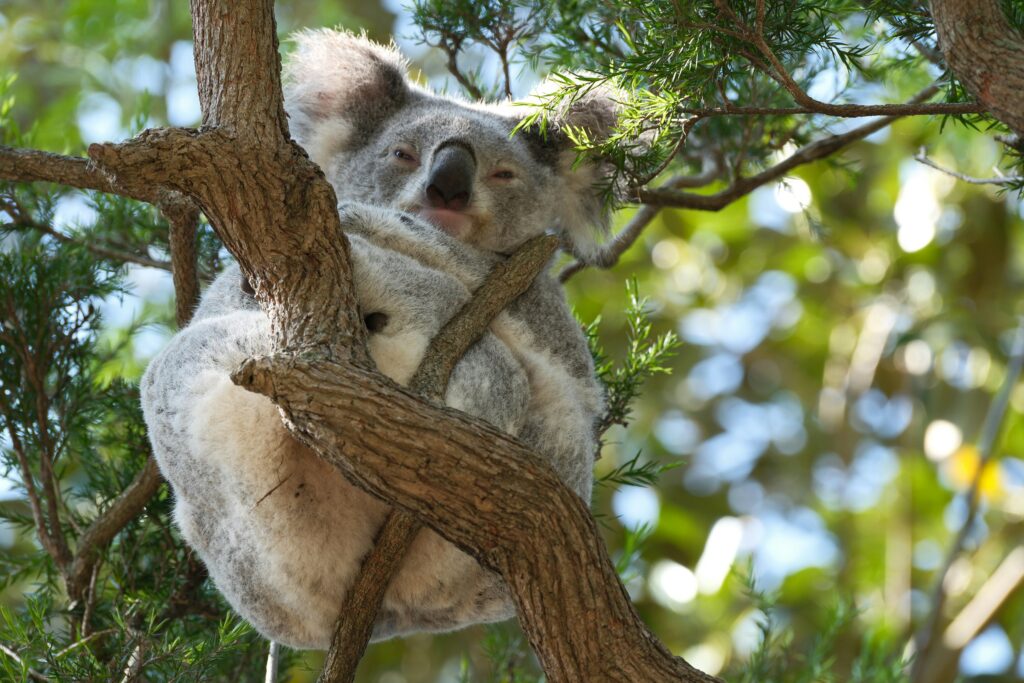
Of course, eucalypts are by far the most important food source for koalas. However, koalas are known to eat many non-eucalypt species, such as Melaleuca and Casuarina. There are even good records of koalas on French Island in Victoria subsisting for long periods on Radiata Pine, a conifer indigenous to North America!
Unlike the other topics discussed above, a lack of data on Drop Bears means I cannot with certainty confirm them as a myth. Eucalypts support such a diversity of wildlife – why not Drop Bears too? To err on the side of caution, it’s best to mention Drop Bears (and their love of Vegemite) to any overseas tourist travelling in Australia.
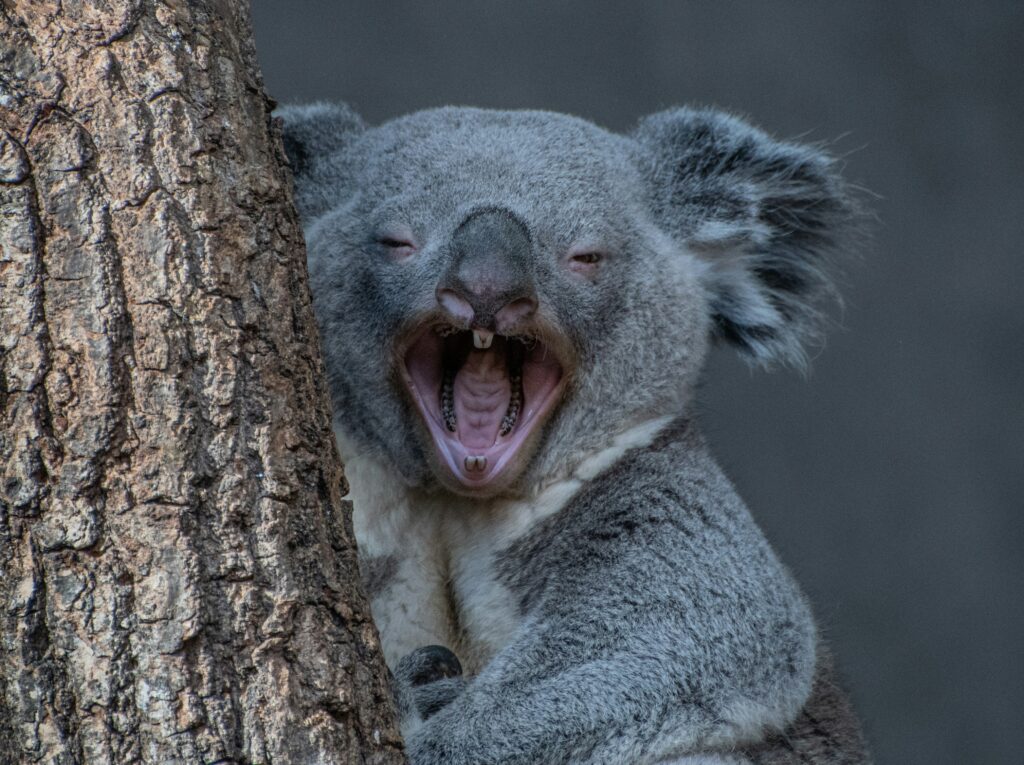
Dean Nicolle would like to give special thanks to Dr Tim Curran (Lincoln University), Dr Ben Moore (Western Sydney University), Denis O’Bryan (Red Eagle Bushfire Protection Services), Prof Matt Ritter (Cal Poly State University) and Assoc Prof Jenn Yost (Cal Poly State University) for making available preliminary data and commenting on the manuscript.
Cover image is of an Illyarrie (Eucalyptus erythrocorys), voted 2020 Eucalypt of the Year. Courtesy of Catherine Cavallo.
11 Responses
Thank you for the answer for all those mythical deterrents to Eucs/gums being more widely enjoyed and planted in our ‘burbs. One question that occurs to me, we now , in WA have Kookaburras and Rainbow Loorikeets , whether we want them or not but if Koals eat WA Eucs why do we not have them here, ok they haven’t mastered flight yet , neither have cane toads, so surely we could spread their population a little?
Excellent article and a great resource to share with clients and anyone who has heard of (and believes) many of these myths. Thanks Dean.
Very interesting article, Dean. I do worry a little about the Wadbilliga Ash (E. paliformis), Woila Gum (E. olsenii) and Jilliga Ash (E. stenostoma), now that you have mentioned that they have been victims of the recent fires.
Very interesting article. Thank you!
Great article, thanks very much
thank-you for settling those myths. I am always amazed that people generally believe that trees, if they choose wisely enough, wont seek the opportunistic moisture of pipes or the cool of housing foundation in a hot harsh dry environment. I have also always wondered about the ‘blue haze’, seen over the Blue Mountains in NSW claimed by some to be the eucalyptus oils over the Eucalyptus bush on a hot day. How come all mountains look blue in distance, even in other country’s?
It is sad about the number of obligate seed growing being wiped out in the recent fires, I wonder how many other bush species suffered the same fate in the terrible hot fires of last summer. Thank-you again.
That’s incredible, there are so many eucalypt species in Brazil, I was taught in college that the species we grow koalas wouldn’t feed on, though (not core to my major).
Males me wanna bring some koalas over and rear them in the wild here.
Eucs help save Brazilian forests, they occupy less than 2% of territory but provide 2/3rds of all wood, big help.
Excellent article, everyone needs to know this information!
Excellent article. as a practising arborist for over 30 years it’s great to read articles that expose the false beliefs surrounding Australia’s iconic and valuable tree species.
A delightful article thanks…..hope EVERY household picks up the idea and plants one, even the larger versions ….especially in the ugly denuded suburbia of our cities…Nothing more beautiful than
canopied streets of Eucalypt/Angophera
Wow, How interesting.I have gained so much knowledge after reading this. Thank you for sharing.